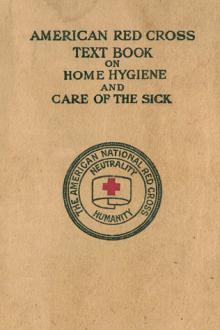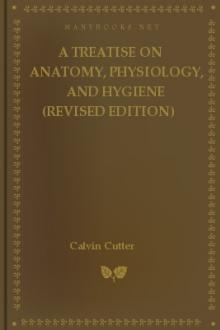American Red Cross Text-Book on Home Hygiene and Care of the Sick by Isabel McIsaac (best affordable ebook reader txt) 📕

- Author: Isabel McIsaac
- Performer: -
Book online «American Red Cross Text-Book on Home Hygiene and Care of the Sick by Isabel McIsaac (best affordable ebook reader txt) 📕». Author Isabel McIsaac
Symptoms may be divided into two classes: first, objective symptoms, or those that can be noted by an observer, like cough, pulse rate, or color of the skin; and second, the subjective symptoms, which are apparent only to the person affected, like pain and fatigue. The success of any woman who cares for the sick depends to a large extent upon her quickness and accuracy in noticing and reporting these symptoms and their variations. It should be remembered that pronounced symptoms are not the only ones of importance: even slight symptoms that continue over an appreciable length of time may be of very great importance. A brief description of some important symptoms follows, in order to help persons without technical training to describe the symptoms as well as to observe them.
OBJECTIVE SYMPTOMS—Bodily heat is produced by slow burning of food materials, which goes on for the most part in actively working muscles and glands. Heat thus generated is distributed by the blood to all parts of the body, but the surface of the body is generally cooler than the interior. In health the body temperature varies only a few degrees, no matter how much the temperature of its surroundings varies; consequently a temperature is abnormal if it is higher or lower than the usual temperature of a healthy person.
Clinical Thermometer.
The temperature is taken by means of a clinical thermometer placed either in the mouth, the rectum, or the armpit (axilla).
To take the mouth temperature, first wash the thermometer, using cold water and absorbent cotton or clean soft cloth. Next shake it until the mercury thread registers 96° or below. It is well before purchasing a thermometer to see whether it can be shaken down easily. Next place the thermometer in the patient's mouth, with its bulb under his tongue; he must then keep his lips closed until it is removed. Leave the thermometer in his mouth for two minutes. Then remove the thermometer, read the temperature and record the result. Clean the thermometer at once, using first cold water and soap, and then alcohol, 70%.
The mouth temperature of a healthy person is about 98.6° F. This statement holds true if the person has been sitting with his mouth shut for a little while before his temperature is taken; but a hot bath, breathing through the mouth, eating or drinking, and so forth may cause marked temporary changes.
The temperature in the rectum generally varies less than the temperature in the mouth unless it is taken when the rectum contains fecal matter. The temperature should be taken by rectum in babies and young children, restless, drowsy, or delirious patients, patients who cannot be trusted to keep the thermometer under the tongue, mouth breathers, and in any patients who have difficulty in keeping the mouth shut. The temperature is normally about half a degree higher in the rectum than in the mouth.
In order to take a temperature by rectum, adults generally find it more convenient to lie on the side and prefer, if they are able, to insert and hold the thermometer themselves; but the attendant should be certain that they can do so without breaking the thermometer. Rectal thermometers should be lubricated with oil or vaseline before using; they should be inserted about two inches, left in three minutes, and cleansed in the same way as the mouth thermometer. A thermometer used to take rectal temperatures should never be used in the mouth.
In taking the temperature of a baby place him on his back, hold him firmly with his legs elevated, and carefully insert the bulb of the thermometer, well oiled, for about one inch. Keep the child quiet, and hold the thermometer in place three minutes. Great importance should not be attached to a slight fever of short duration. The temperature of a child is much more easily affected by slight causes than that of an adult, and rectal temperatures between 97.5° and 100.5° should not cause anxiety unless continued.
Temperatures taken in the axilla are less accurate than those taken by mouth or rectum. Consequently the method is less often used. The axilla should first be wiped; then the thermometer should be inserted and held for 5 minutes by pressing the arm tightly against the chest wall. The temperature in the axilla is normally about half a degree lower than in the mouth.
The temperature varies somewhat according to the time of day. It is not unusual for the mouth temperature of persons who are entirely healthy to be as low as 97° in the early morning, or as high as 99° in the late afternoon, and probably most people's temperatures vary as much as a degree during the twenty-four hours. Even greater variations that are not long continued have little if any significance in people who feel well.
Decided variations either above or below normal are highly important symptoms. A temperature below 98° is called subnormal, and one above 99.5° is called fever. The number of degrees of fever does not necessarily bear a direct relation to the severity of an illness. Thus, it does not follow that one person is twice as sick as another, because his temperature is twice as many degrees above normal. All symptoms, including variations in temperature, must be considered in connection with one another, and it is generally impossible to state the significance of any one symptom taken by itself.
The temperature should be taken once or twice a day as a matter of routine in almost every form of illness, and oftener when the patient's condition requires it. Also it should be taken as a matter of routine whenever there is indication of beginning sickness; especially when there is headache, pain, sore throat, coated tongue, cough or cold, chill, vomiting, diarrhœa, or rash. It is not a good plan to take one's own temperature oftener than necessary, or indeed anyone's; certainly not a baby's, since frequent use of the thermometer may irritate the rectum.
—Each time the heart beats, blood is forced out from the heart into the arteries, thus causing an expansion of the arterial walls. This expansion, called the pulse, can be felt in some places where arteries lie close to the surface of the body. The character of the pulse beat and its rate, or the number of times the beat occurs each minute, give information about the heart and blood vessels; taken together they are perhaps more important than any other one symptom.
The pulse rate varies much more than the temperature. It differs in different individuals and at different ages, and it often shows great temporary changes, especially during exercise or eating, or as a result of excitement, fear, or other emotion. Definite statements in regard to normal pulse rates are hard to make, because different individuals though in perfect health show marked variations; we generally say, however, that the pulse rate of a normal man at rest is about 72 a minute, and that of a normal woman is about 80 a minute. At birth the pulse is quickest; it may then be from 124 to 144. From the 6th to the 12th month it may be from 105 to 115 a minute, and from 90 to 105 between the 2d and 6th years. About the time of puberty it reaches the adult rate, and during old age it may be decidedly slower than the adult rate.
What we chiefly want to know about the pulse is
1. Its rate, or number of beats per minute,
2. Its force,—whether weak or strong,
3. Its rhythm,—whether regular or irregular.
Much practice is necessary before the pulse rate can be counted with any degree of accuracy, and wide experience with both normal and abnormal pulses is required in order to judge its strength, rhythm, or other characteristics.
The pulse may be felt most conveniently on the thumb side of the front of the wrist. The pulse should be counted while the patient is lying down, and the watch used must have a second hand. To count the pulse, one should place two or three fingers (not the thumb) on the patient's wrist, and after the pulse has been felt distinctly for a few beats, the exact time by the second hand of the watch should be noticed and the counting begun immediately. It is generally best to count for half a minute, multiply the result by two to get the rate for a whole minute, and then to repeat for another half minute. The two results should agree within two beats, if the patient is quiet. A greater variation than two beats may mean that the pulse rate is varying, but when it is counted by inexperienced persons the apparent difference is generally the result of inaccurate counting, and it may be necessary to count two or three times more. The force of the pulse varies also in different individuals; it is, however, important to notice when it grows stronger or weaker in the same person. Normally the pulse-beat is regular like the ticking of a clock; it is called irregular if a few rapid or slow beats are followed by others of a different rate. During sickness the pulse should be counted whenever the temperature is taken, or oftener; and the result should be written down at once. The pulse of a sick person often shows changes both in rate and character; these changes are generally important and should be noticed.
—Variations in the rate and character of respiration or breathing should be noticed. The normal rate of respiration for an adult at rest is 16 to 20 each minute, but it may be much faster, especially during muscular exercise. In babies the rate is about 30 to 35 a minute, and 20 to 25 in little children. The respirations, especially of babies, can best be counted during sleep by placing the hand lightly on the chest or abdomen. Since the respiration rate is partly under a person's control, it is almost sure to alter if the patient knows it is being counted; hence when the patient is awake it is better to keep one's fingers on his wrist, to place his hand upon his chest, and then to count the rise and fall of the chest while apparently counting the pulse. Sometimes it is possible to count the respirations merely by watching the rise and fall of the nightgown or bed clothes. The respiration is usually counted for a full minute. A watch with a second hand must be used, and the result should be recorded immediately.
In certain forms of sickness breathing may become rapid, especially if the lungs or air passages are affected. In addition to the rate anything unusual about the breathing should be noticed whether it seems difficult or painful; if noisy, whether the sound is like snoring, or wheezing, or sighing, and so on.
—Any unusual expression of the face should be noted; whether it is drawn, pinched,





Comments (0)